Tyne and Wear, England
 Unsung Heroes
Unsung Heroes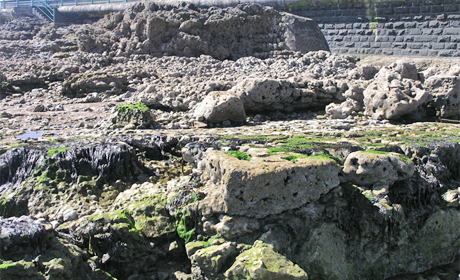
The spectacular sea cliffs are key to understanding the original Magnesian Limestone succession and the catastrophic marine inundation that created the Zechstein sea and deposited marine limestones on top of aeolian dune sands.
In the lower, older parts of the succession there are algal limestones, evaporite residues, limestone turbidites and large scale submarine slides. Higher up are beds that have been chemically altered and now contain a variety of concretions including the ‘Cannon Ball’ limestone (see image above), plus spectacular dissolution pipes filled with collapse breccia.
Eric Johnson
Nominated by: Eric Johnson
The coast of north east England between South Shields and Sunderland provides an almost 10 kilometre long continuous exposure of internationally famous parts of the Magnesian Limestone. Other important exposures of these same rocks also occur in a few nearby inland localities, mainly abandoned quarries. Although modern formal stratigraphical nomenclature now requires us to refer to this fascinating succession of marine Permian rocks as the ‘Zechstein Group’, they are so well known both in the geological and ecological literature as the ‘Magnesian Limestone’ that this term will be used here.
These often highly unusual rocks have attracted attention since the earliest days of geological science, though modern interpretations of their origins and true international significance result predominantly from the work of the late D B Smith. Key modern summaries by Smith (1994 and 1995) and Stone (et al (2010) include references to the very extensive detailed technical literature dealing with these rocks. In addition, Smith (in Scrutton, 2004) has produced an important field guide to parts of the Sunderland and South Shields areas. It is only possible here to highlight a handful of the most interesting and important features visible.
The lowest Permian rocks of north east England, the Basal Permian ‘Yellow’ Sands (Rotliegende Group) and the overlying thin bituminous limestone of the Marl Slate, and dolomitic limestones of the Raisby Formation (Zechstein Group), crop out on the coast at Frenchman’s Bay [NZ389 662], though they are commonly obscured by cliff falls, and approaching the exposures is usually difficult and dangerous (Figure 1). These formations are best examined in inland exposures south of Sunderland and are not considered further here.
|
Figure 1. Frenchman’s Bay
Pale greyish collapse-brecciated Concretionary Limestone Formation overlying pale yellow bedded Raisby Formation limestones. The Basal Permian Sands and Marl Slate crop out at the foot of the cliffs at the head of the beach, but are completely concealed beneath a large cliff fall. Photographed in 2010.
|
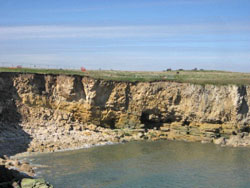 |
At Trow Point [NZ383 667], the well-bedded dolomitic limestones of the Raisby Formation (formerly known as the Lower Magnesian Limestone), which here include prominent cavities believed to represent original anhydrite nodules, are overlain by a thin (up to 0.6 m) oolitic dolomite with stromatolites, known as the Trow Point Bed (Figure 2).
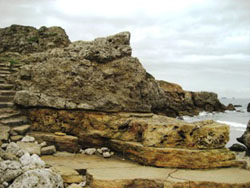
|
Figure 2. Trow Point.
Bedded yellowish Raisby Formation limestones, with numerous cavities after anhydrite nodules, are overlain by the thin Trow Point Bed, on which the hammer rests. Above this lies the residue of the Hartlepool Anhydrite which is, in turn, overlain by collapse-brecciated limestones of the Concretionary Limestone Formation.
|
This is overlain by a conspicuous thin (up to 0.1 m) bed of sandy clay which is the residue left by the complete dissolution of the Hartlepool Anhydrite Formation. This evaporite bed is up to 100 m thick where unaffected by dissolution in the adjoining offshore areas.
Collapse of the overlying limestones of the Concretionary Limestone Formation (formerly part of the Upper Magnesian Limestone), into the void left by anhydrite dissolution, has produced spectacular collapse-breccias.
A variety of collapse-brecciated lithologies within the Concretionary Limestone Formation, exposed within the sea cliffs south of Trow Point, and seen in particularly fine exposures at Marsden Bay [NZ398 651], are some of the finest examples of these rocks available for study anywhere in Britain or Europe (Figure 3).
|
Figure 3. Marsden Bay.
Severely collapse-brecciated bedded limestones of the Concretionary Limestone Formation.
|
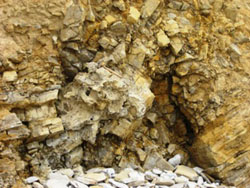 |
The Concretionary Limestone Formation takes its name from the widespread abundance of a variety of curious post-depositional concretionary structures. Perhaps best known of these is the ‘cannon ball limestone’, so called from the presence of almost perfectly spherical concretions which range in size from a few millimetres across to ‘cannon balls’ over 0.3 m in diameter. Such concretions are preferentially developed along some beds, though in places their development has almost entirely obliterated the original bedding.
Especially spectacular examples of these rocks may be seen in the sea cliffs south of Souter Point [NZ414 526] (Figure 4) and at Roker Promenade [NZ407 596]. Internally the ‘cannon balls’ typically comprise massive limestone, though some display a faint concentric banding.
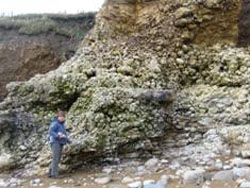
|
Figure 4. South of Souter Point.
A fine exposure of typical rounded ‘cannon ball limestone’ within the Concretionary Limestone Formation.
|
In places, notably in Marsden Old Quarry Local Nature Reserve [NZ397 646]and in the long abandoned Cleadon Park Quarry [NZ385 641] (Figure 5), now a public park, the concretions take the form of spectacular star-like radiating aggregates of calcite crystals up to 30 mm, or locally more, across. Elsewhere, rod-like or finger-like concretions, commonly exhibiting a radiating form and giving rise to strange fan-like aggregates, are found. In all cases the concretionary structures comprise almost pure calcite. In fresh or lightly weathered exposures they are seen to be surrounded by a rather friable matrix of rather powdery yellow dolomite (Figure 5): this matrix is typically removed rapidly on weathering.
|
Figure 5. Cleadon Park Quarry.
Radiating stellate calcite concretions with remnants of powdery yellow dolomite matrix.
|
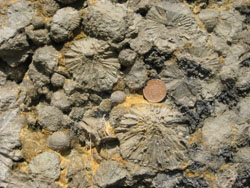 |
These strange rocks result from the process of de-dolomitisation of an original dolomitic limestone, whereby calcite has segregated into the hard concretions with dolomite forming the softer matrix. All of these rocks in the coastal exposures are affected by the collapse-brecciation associated with dissolution of the Hartlepool Anhydrite, referred to above.
Coastal erosion has produced a number of prominent sea stacks, including Marsden Rock [NZ401 649] (Figure 6) and Lot’s Wife [NZ398 651],where the collapse-brecciated limestones have proved particularly resistant to erosion.
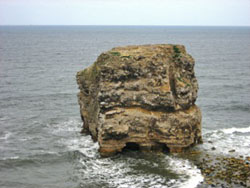
|
Figure 6. Marsden Rock.
A large sea stack composed of collapse-brecciated Concretionary Limestone Formation.
|
The magnesium-rich soils of the Magnesian Limestone support an ecological habitat, rich in colourful flowers, known as Magnesian Limestone grassland, excellent examples of which are to be found adjacent to Marsden Old Quarry [NZ397 646].
Text: Brian Young
(Honorary Research Fellow, Department of Earth Sciences, University of Durham)